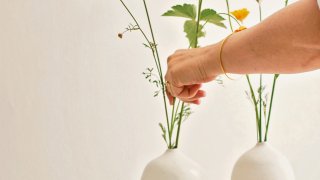
Their reasons may differ, but crafters agree: Makers gotta make. Those who create things by hand — who weld, weave, play in clay or paints — are pursuing their passions the best they can during the coronavirus pandemic.
The creative arts are soothing, fill time, and keep our minds and hands busy.
“This is what makes us human,” says Melanie Falick, author of the recent “Making a Life: Working by Hand and Discovering the Life You Are Meant to Live” (Artisan).
Falick, a longtime craft books publisher, quit her job to follow her maker’s heart. Her book is filled with stories of weavers, ceramicists, welders, woodworkers, quilters and more, with photos of the art, the crafts, homes and workspaces.
Get San Diego local news, weather forecasts, sports and lifestyle stories to your inbox. Sign up for NBC San Diego newsletters.
Falick examines how making by hand contributes to a good life. For starters, makers find balance in creating, she says. They may have jobs, families, bills, responsibilities, but crafting provides a needed and active break.
“I feel grounded and at home in my skin, in my body, when I’m doing something with my hands. There’s that part of it,’’ says Falick from her home in Beacon, New York. She’s crocheting a hat while we talk. "There’s so much coming at us right now that is overwhelming. This calms me, centers me, grounds me. I feel alive in a healthy way. I’m less frazzled.”
Brian Kasstle of Las Vegas, Nevada, says he doesn’t feel like himself when he’s not engrossed in art journaling, using collage, painting and image transfers. Each journal page tells a biographical story.
Right now, the airline customer service representative needs his craft more than ever.
“I’m in the public eight hours or more a day. I deal with so many people. I don’t know if I’ll get sick. It’s a really nice diversion to get lost in my art journals,” he says.
Sarah Raven, a fifth-grade science teacher in New York City, has time on her hands now that she’s teaching students online and staying home. She first made small beads out of modeling clay; she’s now “paint pouring” with acrylics, a technique she’s learning from YouTube videos.
“Why do I have to create? I have something inside of me that I feel I have to express, to get out,” she says. “Creativity is the opposite of destruction, and at a time when there are so many destructive things happening, it seems logical to want to create things.”
Darrel Tenter of Helena, Montana, likes making for its own sake and for the end product, sometimes decorative, often utilitarian. The education technology consultant crafts leather products — wallets and satchels — and welds things, like the shelves in his home office.
“I like being creative and trying new stuff, but I tend to get bored after a while and shift to other things,” Tenter said.
Time flies by for Tenter in his workshop.
“Especially when I’m out in the garage doing welding, the next thing I know, it’s 1 o’clock in the morning and I’ve been out in the garage for eight hours.”
Trisha Himmler, a brand manager and graphic designer in Denver, has dabbled in many crafts. She’s an expert sewer who designed and sewed a friend’s wedding dress from a mere photo. Her latest go-to craft: embroidery. She started with a kit before going free-style and drawing her own patterns.
“I like being able to do a project and say, ‘I made that.’ It’s validating about your abilities as a human, and not just being a drone who works a job, comes home, watches TV and then repeats,” she says.
Laura Plouzek, of Wahiawa, Hawaii, is taking crafting one step further during the coronavirus outbreak: She not only crafts for herself and makes outlandish bow ties for a living, but she recently assembled crafting care packages, mailing 42 kits worldwide.
“I really wanted to share some joy during a time that might be full of anxiety for many,” Plouzek says. The kits include felt, ribbons, thread and more to create diminutive award badges.
“Making for me is at the core of who I am,” says this mother of three elementary-school children, whose Etsy shop is called xoelle.
Falick believes creative expression is key to health and wellness. She paraphrases scholar Ellen Dissanayake, who has studied the intersection of art, evolution and other sciences: “Art is wired into us. It is the act of making the ordinary extraordinary.”

